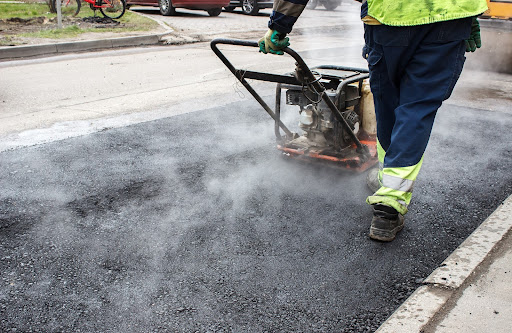
Potholes are a nuisance to both motorists and pedestrians. They pose a safety hazard for many while making the area less attractive. So, when you’re faced with a pothole that can cause costly damage and injury, patching it up right away is a must.
Essentially, potholes are broken parts of the road’s surface layer. When the said layer, which is usually made of asphalt, cracks and is broken away by water damage or stress from traffic passing over it, it usually forms depressions or holes.
Potholes can start small but can easily expand and deepen if not addressed properly. Additionally, while this type of road damage is usually seen on asphalt roads, it can still happen on all other road types.

Several factors contribute to the formation of potholes, making it complex. It has several stages to it.
Potholes usually start when there’s a crack in the road. This is usually caused by fatigue from passing traffic, especially when the material used is sub-park, making it lack the strength needed to withstand pressure.
Other factors may also contribute to cracking, including bad water drainage, old asphalt, thermal movements in the soil that cause shrinkage cracks, and utility works.
The second stage is when water seeps down these crafts. This wets the layer of material underneath, causing it to weaken. Water also softens the soil under the road, causing movement and aggravating the cracks.
Moving traffic then worsens the damage on the pavement. This causes the craft to become a pothole as the damage grows bigger and deeper. On top of this, the moisture exacerbates it as water expands and contracts depending on the weather.
Potholes are one of the biggest safety hazards on the road in several ways. While they look innocuous, they pose a larger threat to motorists and pedestrians alike.
For one, potholes can cause severe damage to a vehicle. It can blow out tires, misalign them, and damage car suspensions.
A bigger problem is that it can cause accidents and injuries to drivers and pedestrians. If you run over a pothole in a vehicle, you may lose control of it. It’s even more dangerous for motorcyclists and cyclists as they can be thrown off the vehicle if they run over a pothole.
There are many different pothole patching techniques professionals use. Each has pros and cons, depending on how large the holes are and how severe the damage is. Here are some of the most common ones:

Cold patching is likely the fastest and most inexpensive way to fix a pothole. It involves pouring in a pre-mixed asphalt material that doesn’t need heat to cure.
Pros: Easy to apply, no need for special equipment, best used in emergencies
Cons: Not a good fix for long term, prone to breaking in heavy traffic areas
How to Apply a Cold Patch:
Another way to cover a pothole is by infrared patching. This method uses infrared technology to heat the damaged asphalt and surrounding area. Doing this makes it malleable and easy to shape. New asphalt is blended with the heated material and compacted to provide seamless repair.
Pros: Durable, cost-effective for medium-sized repairs, creates a smooth finish.
Cons: Will need special equipment and trained personnel to operate the equipment
How to Do Infrared Patching:
As its name suggests, this method involves milling. In particular, you must mill out the damage until it reaches a specific depth. You will add the new asphalt to this.
Pros: Very durable, best used for large potholes and areas with high-traffic
Cons: Time-consuming, uses a lot of resources and heavy equipment, and is expensive.
Steps for Mill Patching:

When doing dugout patching for potholes, you will need to excavate the pothole area and a part of the surrounding road.
Pros: Extremely durable, best used for severe and recurring potholes
Cons: Labour-intensive and expensive
Steps for Digout Patching:
If you want to fix potholes correctly, you must avoid common mistakes that compromise the quality. Here are some of them:
Repairing potholes comes with its own set of challenges. Here are some that you may encounter:
Fixing a pothole correctly requires understanding what caused it and choosing the proper method, depending on the case. Investing time and resources in proper techniques will ensure safer, longer-lasting results. By addressing potholes as soon as possible, you can protect vehicles, pedestrians, and the integrity of the road itself.
Pothole Repair Carolinas offers pothole patching services around North and South Carolina. Call us today at 704-227-0468 or contact us online for more information!
RELATED ARTICLES: